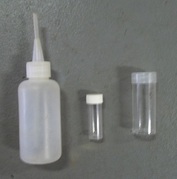 My pack
My pack After 50 years of mining I've got my backpack down to the minimal. Some of this stuff I use occasionally. Most of it, I use all the time. There are times where I wish I had another tool or two. But at the end of the day, hiking up the hill I don't miss it having them at all. If I have an easy hike or am flying in, I will take the larger hammer a larger pan a few more things that I think I might need. The equipment in my pack does include tools that are used while metal detecting. I can't remember the last time I went without taking my detector. Doesn't matter if I'm detecting or not, they always go.

- 10" Gold Pan;
I take a small cheap plastic gold pan. For a few reasons. It fits in the pack very well. Its light. If I like an area and plan to come back regularly. I will leave the pan there, that way I can pack one less thing. If I bring a friend, I don't have to bring a pan for him and if I don't go back, or it's lost I'm only out a couple bucks. If I know I'm going to do a lot of panning, I will throw and a 14 inch pan.

I don't think I could mine without this tool. Buy a good one, and it will last you for decades. I have a 14 oz and a 23 oz hammer. I carried the small one in my backpack . I found it in the bottom of a hole I was dredging in 1988. And have been using it ever sense. Buy a cheap one, and it will only last a few weeks, if you don't hurt by it first. A small or medium chisel is a another item I can't do without.

A GP-18 or gad pry bar, made by Estwing. I think is the best pry bar ever made for mining. I have been using the same one for 25 years now . You can use just about any type of pry bar. But there are few things that it has to do. Fit in the pack, be light, and not bend or break.

You will use these more than any other tool. I use a variety of crevice tools. I have thin blade tools, wide blade or standard, and a long spoon ( huntly spoon) to get way down in the crevice. My spoon is about 20 inches long with a sharp hook on the other end. The flat blade is about 15 inches long. The two thin blade are 12 and 18 inches long. Over the years I had trouble finding a crevice tool I liked. I tried buying tools, I'd tried making tools. I have made crevice tools out of old butter knives and steak knives. I've made them out of windshield wipers and old leaf rakes, and a lot of other stupid things I wont mention here. All the crevice tools in my pack I've made. What I'm getting at is, its possible to make your own crevice tools. That way they will fit your own particular situation. But be sure to use a hard metal, preferably spring steel. Because it's gonna get a lot of wear.

This is one of the most timesaving tools you can take a long. When panning, I don't take a lot of time picking out the fine gold. I just suck it all up ( gold and black sand) in the bottle and throw it in the pack. When I get home I dump it in a jar and let it accumulate all summer. Then during the winter, when I have more time I will clean it up. I always take two plastic gold bottles. A small one for most of the gold. And a large one for the nuggets I hope to find.

I carried two pair of locking tweezers, one straight one curved. I also find a seal pick a very handy tool for hooking little piece of the gold and pulling them out of the crevice. A small brush for sweeping out the crevice. A teaspoon bent and ground to a point for scooping the material up. Both are very handy. I find I use a regular slotted screwdriver quite a bit.

If I know I'm going to be working a distance from the water. I will take a 5 gallon bucket to pack material back to the river. I do this very rarely, because packing a bucket back up the hill is a real pain. If I'm going to keep going back all summer I will leave the bucket, that makes the of trouble packing it in and out worthwhile.

A good pair of headphones is an absolute must. A good strong magnet will save you a lot of time trying to find a small piece of metal. A good strong rake will speed up trying to find that target by spreading the dirt out so you can pinpoint.
Over the years I've gone through a lot of backpacks. I have tried all sizes and what I've found is, if you get one that is too large you'll end up taking stuff you won't use. When filling your back in the morning think about the hike out in the afternoon. If it is a flat easy hike - go ahead and take that extra stuff. If its a long steep hike in hot weather, you might want to leave a couple of things and take extra water.
| | |
 RSS Feed
RSS Feed